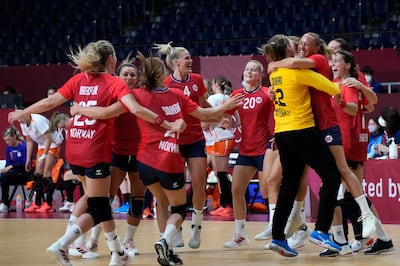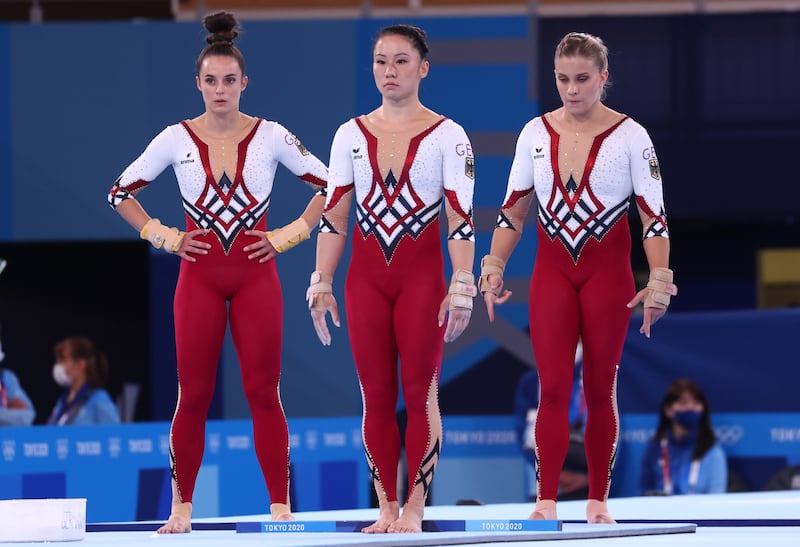Sport is famously considered non-political, a place where people can gather from around the world, put aside differences and compete for glory, pushing themselves – as the Olympics motto says – faster, higher, stronger. But international sport is a platform where some of our knottiest political and cultural issues play out.
Apartheid-era South Africa faced a barrage of sporting boycotts. In 1968 at the Olympics the gold and bronze medal winners of the 200 metres, John Carlos and Tommie Smith raised their fists to protest the Vietnam War and race relations in America. Next to them stood the white silver medal winner Australian Peter Norman.

This time, at the Tokyo Olympics, it is women, their bodies and their choices that have taken centre stage. The German female gymnastics team decided to take part wearing full body unitards, rather than the more common bikini-cut leotard, in a stand against "sexualisation".
This is to the backdrop of a sport rocked in recent years by the revelation of widespread sexual abuse of female athletes. German team member Sarah Voss said: “We want to make sure everyone feels comfortable and we show everyone that they can wear whatever they want and look amazing, feel amazing, whether it is in a long leotard or a short one." It’s about a platform for change. She went on to say: “We want to be a role model in any case, to make everybody have the courage to follow us."
This follows on the back of the Norwegian female beach handball team that refused to wear the regulation bikini bottoms, which according to the International Handball Federation regulations, should be "a close fit and cut on an upward angle towards the top of the leg and a maximum side width of four inches”. Instead, the team opted for shorts similar to those worn by their male counterparts – and promptly fined for doing so.

"It's completely ridiculous," tweeted Norway's Minister for Culture and Sports, Abid Raja: "What a change of attitude is needed in the macho and conservative international world of sport." And there it is, the heart of the matter, the belief which some people still hold, that female athletes take part in sport for the male gaze.
Some would argue that historically, women in sport have been of little interest to men and while things are slowly changing, female athletes were paid less, viewed less, respected and celebrated less. The disparity in women’s remuneration in sports is widely known, the attempt at justification being the fact that apparently women’s sport is not as good and not watched as much. But these are perpetuated by societal ideas that women aren’t as good at performance sport as men.
A Cambridge University Press study in 2016 looked at the differences in how we talk about men and women in sport, analysing over 160 million words used within the domain of sport. Female athletes suffer a focus on aesthetics over athletics and are connected with words such as: aged, older, pregnant, and married or unmarried. Men, on the other hand, are associated with adjectives such as: fastest, strong and great. Men are also connected with verbs such as win, beat, dominate and battle, whereas women have their performance dialled down to the words: compete, participate and strive.
When England’s male football team recently made it to the UEFA cup final it was said to be the first time that "we" made it to a major tournament final since 1966. Except for the fact that the women’s team made it to the Euros final in 2009. Nowhere has women’s participation in sport for aesthetic reasons been clearer than in the case of Formula 1 and the "grid girls" present to add "glamour" to the sport, while the drivers were men. Time was called on this outdated sexism in 2018.
We talk about clothing as though it is trivial or superficial. But like in all walks of life, clothing becomes symbolic of wider social issues. The German and Norwegian female athletes have had to spell out the societal problems: sexualisation and double standards. A uniform is a visible articulation of values. And the sport outfits demonstrate this clearly.
It is interesting that often when Muslim women raise the idea of more body coverage they can be dismissed as oppressed and backwards, whereas when the Germans and Norwegians have done so they are celebrated and cheered. This itself is another important point of social commentary – about which women’s voices are heard and who has the right to self-determination. Nonetheless, the German and Norwegian women are being cheered on and rightly so.
The platform of sport demonstrates clearly how we minimise and sexualise women. Sport makes us confront the values and constraints we place on women in public spaces. It's a good thing that at least in the field of sport we are at last seeing a change in the ideas and attitudes towards women.





